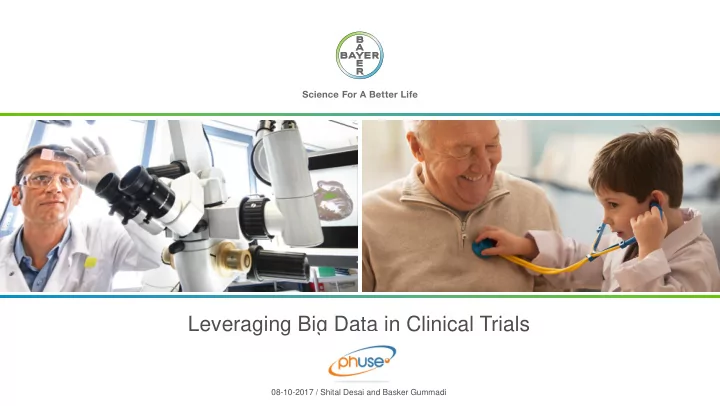

Leveraging Big Data in Clinical Trials 08-10-2017 / Shital Desai and Basker Gummadi
Disclaimer The opinions expressed in the white paper are those of the authors and do not necessarily represent the opinions of PhUSE, members' respective companies or organizations, or regulatory authorities. The content in the document should not be interpreted as a data standard and/or information required by regulatory authorities .
Agenda 01 05 Historical Collaborative Efforts Analytical Ecosystem as Next Generation (Transcelerate Database) Use of Big Data 02 06 Proposed Ecosystem as Next Generation Big Data in Clinical Trials Use of Big Data 03 07 Use Case: Data Mining of Genomics Roche GLIDE Program datasets for Non-Hodgkins Lymphoma Next Generation of Uses: Use Case: Genomics datasets for Non 04 08 Real World Big Data Hodgkins Lymphoma Patient Cohort Clinical Trial Data Sources Flow Analysis Page 3
Executive Summary Industry wide Clinical Trial collaborative efforts offers significant improvement over siloed Executive individual databases in providing superior Patient Outcomes. The efforts however were still Summary limited to Rare Disease categories and Data Sources resulting in limited Clinical Analyses and Insight. An industry wide Clinical Collaborative Data Repository utilizing Big Data will enable Pharmaceutical Cos to utilize new Analytic techniques and optimize Patient Journey from Drug Discovery to bedside treatment. Mining Big • Learn from historical data to optimize Study Design, Conduct and Analysis. Data • Perform simulations to mitigate the risk of time delay for clinical trials. Enables: • Perform predictive modelling with EHR and genomic datasets across numerous data providers. • Glean insights from clinical data including unstructured patient’s notes, scans and pathology reports. • Empowers government agencies, payers, and providers to make decisions about drug discovery, patient access, and marketing Page 4
Potential Sources of Big Data for Clinical Trials
Leveraging BIG DATA Identify Key Success factors, and relevant PLAN Data sources, for your Clinical Study Systematically drive remediation and Analyze Perform Analysis Adjust learning Evaluate Predictions
Key Success Factors for Clinical Trials Patient Selection Data Risk Quality Monitoring Trial Time Drug Design AE Variance Sites Efficacy Cost Variance
Case Study of Big DATA: Roche GLIDE Platform GLIDE ( G lobal I ntegrated D rug D evelopment E nvironment) analytical ecosystem, a next generation data architecture. Roche has identified Real World Data (RWD) - collected outside of a clinical trial - as a source of data type which can help to deepen the understanding of the disease area and ultimately improve access for patients to the medicine. Multiple internal and external data sources are brought into the Teradata integrated warehouse, including: • Trial data/new treatment data (usually in a SAS data set); • Lab data – blood, ECG, X-Ray; • Genetics data; • Electronic data records; • Insurance claims; • Medical data
Next Generation of Real World Big Data Data from the “Internet of Healthcare Things” ( IoHT) and Genomics datasets closes gaps in real world data Gaps In Current Real World Data: • No / unreliable data between encounters • Artificial setting can yield anomalous data • Much of the data is subjective Example : Study of cancer genomes to reveal abnormalities in genes that drive the development and growth of many types of cancer. Understanding of systematic biology results in improved method of diagnosis and treatment.
Analytical Ecosystem as Next Generation Use of Big Data Structured & Medical Inquiries Electronic Medical Records Capabilities Un-structured Data Claims openFDA.Gov Massively Parallelized • Plotting common pathways across Databases Specialty Pharma billions of events Advanced Analytic & • Linked Claims & EHR Visualizing relationships across Discovery Platforms millions of entities Drug & Label Data • Deriving insights with NLP, text Monitoring Data mining, and sentiment analysis Analytic Ecosystem algorithms Pathway • Analysis Detecting anomalies within large Models / Extracts / Dashboards / Text volumes of machine-data Classification Analytic Apps • Accelerating next-generation Entity Recognition predictive models (i.e., Machine- Sentiment Analysis learning) with distributed computing Rapid Cohort Machine Assembly Learning Time-series Affinity Analysis Analysis
Use Case: Non Hodgkins Lymphoma Clinical Trial Involvement of a single lymph node region (I) or localized involvement of a single extralymphatic, Stage I organ or site Involvement of two or more lymph node regions on the same side of the diaphragm (II) or localized involvement of a single associated extralymphatic organ or site and its regional lymph Stage II node(s), with or without involvement of other lymph node regions on the same side of the diaphragm (II) Involvement of lymph node regions on both sides of the diaphragm(III), which may also be Stage III accompanied by localized involvement of an associated xtralymphatic organ or site (IIIE), by involvement of the spleen (III) or by both Disseminated (multifocal) involvement of one or more extralymphatic organs, with our without Stage IV associated lymph node involvement, or isolated extralymphatic organ involvement with distant (nonregional) nodal involvement Bayer 16:9 Template 2010 • October 2016 Page 11
Use Case: Non Hodgkins Lymphoma Clinical Trials Data mining of public Genomics dataset identified the following Patient cohort insights during trail design • The rearranged immunoglobulin heavy-chain variable region genes from both diagnoses were compared to each other. Twenty-six patients presented with both diagnoses. • Twelve had NHL as the primary disorder (“HL first” group) and the majority of these (75%) presented with aggressive lymphoma as the second lymphoma. • In contrast, in the 11 patients for whom NHL was the primary disorder (“NHL first” group), this was usually (82%) of low-grade histology. Three patients were diagnosed concurrently with both diseases. • Leveraging sequence of heavy chain region resulting in identification of prospective patient cohorts for trial hypothesis of primary disorder patients and histology pattern. • Other usage of data mining genetic region included confirmation of Second Line Therapy (bendamustine, bortezomib, rituximab) • Administration of protease inhibitors concurrently with Chemotherapy and verify lack of interactions or changing to non-protease based regimens
Thank you! Q&A
Recommend
More recommend